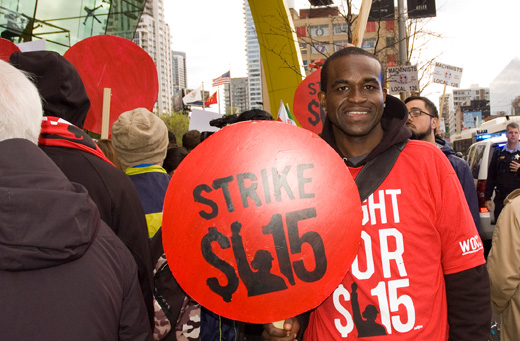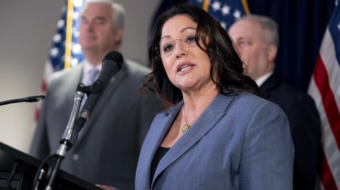
Social change, and especially deep-going social change in a progressive, left and socialist direction doesn’t just “happen.” It requires, first of all, real, active, and politically far-seeing social movements on the ground.
And the labor movement — energized, growing, membership-driven, and class and democratic minded — is an essential cornerstone of those social movements.
Not everyone in the left and progressive community is of this mind. Some assign the labor movement no part in the process of change; some a bit part; others include labor as just one in a list of political actors.
Some greet the new initiatives and new possibilities in the labor movement with faint praise or cynicism. Contrast the reception on the left to Occupy as compared to last year’s groundbreaking AFL-CIO convention! It was gaga in one case and largely ho-hum in the other.
This doesn’t make any sense.
Labor in particular and the multi-racial, female-male, young and old, native born and immigrant, gay and straight, abled and disabled, working class in general are change agents. When organized, united, and equipped with a class and democratic vision, the working class and its organized sector possess transformative power — that is, the capacity, especially when allied to other social movements, to radically and democratically realign politics, economics, culture, and popular thinking.
Of course, labor isn’t anywhere close to being a transformative actor at this moment. In fact, union membership is at its lowest level since World War II. Unions are on the defensive. The internal and external barriers to reconstituting a vibrant and growing labor movement are formidable, and the left in labor, while growing, is still small in numbers.
Now if this were the entire story, it would be a “bummer.” But it isn’t. The story is still unfolding and it includes a significant grouping of labor leaders and activists (some who are not yet, but hoping to be soon, union members) whose aim is to break out of this defensive shell, reshape labor’s understanding of itself and its role in society, organize and welcome millions of new members into the family, and turn the tables on the corporate class and especially its right-wing supporters in the corridors of political power.
To name a few of its most important initiatives:
Organizing low-wage workers;
Reaching out to new allies and social movements;
Drawing people of color and women into leadership positions;
Welcoming immigrants into the labor movement;
Locking arms with brothers and sisters in other countries;
Ramping up labor’s independent role in the political/electoral process.
These initiatives (and the new mentality that accompanies them) aren’t yet the dominant template in the labor movement. But this developing culture of solidarity, struggle, and innovation is gaining momentum – and challenging an old culture of class adaptation, deeply embedded inertia and bureaucratic ways, and conservative, protective, and narrowly job-focused modes of thinking and acting.
In the early 1930s, labor was in a similar fix. I’m sure many at the time, including its friends, entertained doubts about its future. But by the mid-30s, new trends in the working class movement – advocating new policies, slogans, and “outside the box” thinking and organization – caught the imagination of millions of unorganized workers, especially in the basic manufacturing sector. And out of that process – thanks to a new labor organization, the Congress of Industrial Organization (CIO), the actions (spontaneous and organized) and unity of millions, and a growing Communist Party and left – came a revitalized labor movement on a broad scale. And that, in turn, became the power base for a far broader people’s coalition that was at the heart of the political, economic, and cultural transformations that swept our country in that tumultuous decade.
All analogies suffer, and this is one is no different. But I believe that, much like the 1930s, the growth and consolidation of today’s new trends in labor can have a similar trajectory.
Of particular importance to this process is the organization of the vast pool — tens of millions — of low-wage workers in big-box, fast-food, retail and service industries – sometimes called “non-traditional” or “alt-labor.” These workers, if organized, will bring energy, ideas, fighting spirit, connections to their communities, and, of course, numerical strength into the existing labor movement much like the workers in auto, steel, mining, electrical, rubber, etc. did in the 1930s.
Many of them are people of color, women, immigrants, and youth who are also fighting for racial, gender, and immigrant justice and possess close ties to the vast pool of unemployed.
This campaign will extend labor’s organizational presence and reach geographically too – in rural towns, suburbs, and exurbs, red states, and the South and parts of the “heartland.”
Some might argue that these sections of the working class don’t have the same structural economic power that mass production workers had in the 1930s, but strategic power doesn’t simply rest on location in the productive apparatus.
It is built in other ways as well. In fact, ultimately, strategic power is politically constituted. It rests on self-organization and bold initiative, broad, deep, and many-sided unity, independent political action and expansive alliances, a burst of anti-capitalist thinking, and an active left and Communist Party.
No matter how one looks at it, the organization of this massive grouping of the working class – call it “alt-labor,” “non-traditional” or what you will – is a big deal, and not only for the labor movement. The challenge for every democratic, progressive, and radical minded person and organization is to get on board the train.
It is leaving the station!
Photo: Workers and supporters rally for a $15 hourly wage at the Rock n’ Roll McDonald’s in Chicago, May 15, 2014, part of a global day of fast-food worker “Fight for 15” actions. Earchiel Johnson/PW










